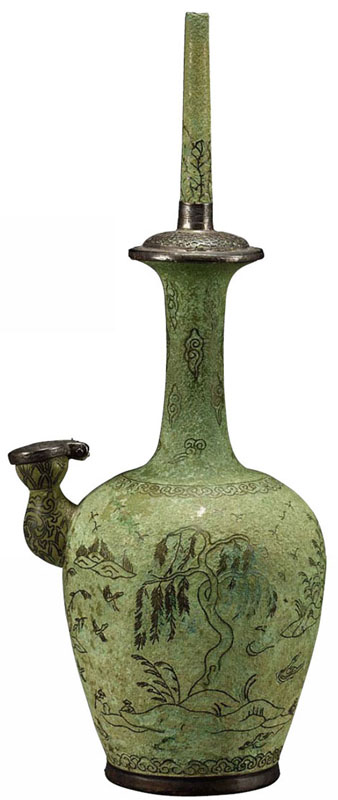- Date2010-10-28
- Hit11293
Ritual Ewer (Kundika)
Ritual ewer is a bottle for sprinkling water used in Buddhist rituals. The ritual ewer features Buddhist craftwork and highly sophisticated shape and design, which includes an incense burner. The ritual ewer originated in India, as it would be a bottle that Indian monks would carry when travelling. The ritual ewer is called Kundika in Sanskrit. It is thought that the bottle would be carried and used by Indian monks for offering clean water to Buddha while traveling.
This ewer complements Koreans’ unique sense of art. The picture engraved on the ewer is of a comfortable landscape, which can often be found in Korean paintings, and there are many empty spaces. Rather than busily filling the picture, Korean painters left spacious margins that invoke a sense of comfort compared to paintings of other countries. These spaces are not meaningless, but rather, grab the viewers' attention to the objects depicted in the picture. This is the exquisite harmony of the negative and the positive that is found in Korean art.
This ewer is a beautiful masterpiece among silver-inlaid bronze ritual ewers. Its blue bronze rust and silver-inlaid patterns stand out much more than the decoration on other ewers. A mace head pattern adorns the ewer’s round body, in which the shoulder is slightly stressed, and different willows are shown on either side of the ewer’s spout in the center. In the spaces among these decorations, a restful riverside scenery-- including small islands, pussy willows, swimming or flying ducks, and a person on a boat, among others images-- is artistically rendered. The spout of the ewer is decorated with a lotus flower arabesque and lotus leaves patterns, and there are clouds on the ewer’s neck and inlaid plantains on its slip cast.
When looking at this picture, we seem to feel, see, and hear the birds flying and the leaves blowing in the wind. The picture on this ewer represents the utopia that people at the time yearned for. This ewer is particularly beautiful because of its unexpected effect: rather than mar its beauty, rust seems to enhance the colors on the ewer. Another form of beauty emerges thence.
Most of the surviving ritual ewers (or jeongbyeong) in Korea were produced during the Goryeo period. They typically have a neck and a finial of roughly the same length, and a body that sharply widens to make a round shoulder from which slowly tapers down toward the foot. However, these features of the earlier period transformed during the Goryeo period to a thicker neck and a lightly higher foot than earlier versions, bestowing upon them a greater sense of balance.
Moreover, the cover of the ewer’s spout and the upper part of the round rim of its base are covered with a silver plate with arabesque patterns that are sculpted to enhance their decorative effect. Although the latter Goryeo period was a very difficult time due to the invasion of the Kitans and Mongolians in the 12th century, these lyrically patterned ewers were introduced then. It seems that their creators turned to nature-inspired designs to dispel worries related to the mundane world.
The number of kundikas with silver inlay gradually decreased during the late Goryeo period. Instead of kundikas in this typical style, kettle-shaped water bottles with slender handles were produced in the Joseon Dynasty period.

Kundika (Ritual Ewer), bronze with silver wire inlay
Location: Metal Crafts Gallery at the Sculpture and Crafts section (3rd Floor)
Period/Date: Goryeo, 12th Century
Accession no. Bongwan 2426
National Treasure no. 92
* This article is extracted from the NMK Magazine Vol.01 & Vol. 11






 X
X  Facebook
Facebook